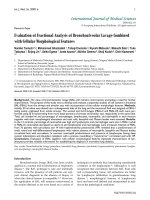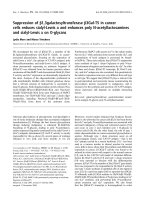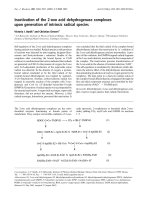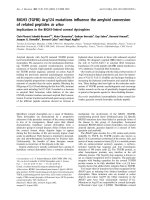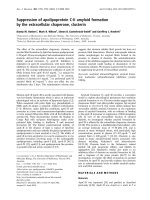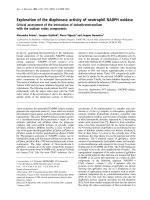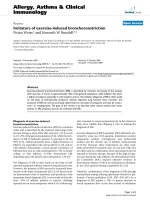Báo cáo y học: ": Suppression of neutrophil accumulation in mice by cutaneous application of geranium essential oi" doc
Bạn đang xem bản rút gọn của tài liệu. Xem và tải ngay bản đầy đủ của tài liệu tại đây (408.59 KB, 11 trang )
BioMed Central
Page 1 of 11
(page number not for citation purposes)
Journal of Inflammation
Open Access
Research
Suppression of neutrophil accumulation in mice by cutaneous
application of geranium essential oil
Naho Maruyama
1
, Yuka Sekimoto
1,2
, Hiroko Ishibashi
1
, Shigeharu Inouye
1
,
Haruyuki Oshima
2
, Hideyo Yamaguchi
1
and Shigeru Abe*
1
Address:
1
Teikyo University Institute of Medical Mycology, 359 Otsuka, Hachioji, Tokyo 192-0395, Japan and
2
Department of Bioengineering,
Faculty of Technology, Teikyo University, 1-1, Toyosato-dai, Utsunomiya, Tochigi 320-0003, Japan
Email: Naho Maruyama - ; Yuka Sekimoto - ; Hiroko Ishibashi - ;
Shigeharu Inouye - ; Haruyuki Oshima - ; Hideyo Yamaguchi - ;
Shigeru Abe* -
* Corresponding author
Abstract
Background: Previous studies suggested that essential oils suppressed the adherence response of
human neutrophils in vitro and that intraperitoneal application of geranium oil suppressed the
neutrophil accumulation into peritoneal cavity in vivo. Usually, essential oils are applied through skin
in aromatherapy in inflammatory symptoms. The purpose of this study is to assess the effects of
cutaneous application of essential oils on the accumulation of neutrophils in inflammatory sites in
skin of mice.
Methods: Inflammation with accumulation of inflammatory cells was induced by injection of
curdlan, a (1→3)-β-D-glucan in skin or peritoneal cavity of mice. Essential oils were applied
cutaneously to the mice immediately and 3 hr after intradermal injection of curdlan. The skin with
inflammatory lesion was cut off 6 hr after injection of curdlan, and the homogenates were used for
myeloperoxidase (MPO: a marker enzyme of neutrophil granule) assay.
Results: The MPO activity of the skin lesion induced by curdlan was suppressed dose-dependently
by cutaneous application of geranium oil. Other oils such as lavender, eucalyptus and tea tree oils
also suppressed the activity, but their activities seemed weaker than geranium. Juniper oil didn't
suppress the activity
Conclusion: Cutaneous application of essential oils, especially geranium oil, can suppress the
inflammatory symptoms with neutrophil accumulation and edema.
Background
Aromatherapy is a folk medicine using essential oils.
Recently the clinical use of essential oils has expanded
worldwide to include therapy against various kinds of
inflammatory diseases, such as allergy, rheumatism and
arthritis. These activities have mainly been recognized
through clinical experience, especially through skin appli-
cation via massage and ointment, but there have been rel-
atively little scientific study on their biological actions.
Several investigators have suggested that tea tree [1,2] and
lavender oils [3] suppressed allergic symptoms through
Published: 10 February 2005
Journal of Inflammation 2005, 2:1 doi:10.1186/1476-9255-2-1
Received: 04 October 2004
Accepted: 10 February 2005
This article is available from: />© 2005 Maruyama et al; licensee BioMed Central Ltd.
This is an Open Access article distributed under the terms of the Creative Commons Attribution License ( />),
which permits unrestricted use, distribution, and reproduction in any medium, provided the original work is properly cited.
Journal of Inflammation 2005, 2:1 />Page 2 of 11
(page number not for citation purposes)
the suppression of histamine release [4,5] and cytokine
production [6]in vitro and in vivo. Moreover, in human,
skin application of tea tree oils was reported to suppress
the edema induced by intradermal injection of histamine
[7]. However, very few reports [8,9] are available on the
inhibitory effect of essential oils on the accumulation of
inflammatory cells, which is a histological character rec-
ognized in chronic inflammatory diseases.
In earlier papers, we reported that the essential oils:
lemongrass, geranium and spearmint suppressed the
adherence response of human neutrophils in vitro [10],
and that the intraperitoneal administration of geranium
oil to mice lowered neutrophil recruitment into the peri-
toneal cavity induced by a chemotactic agent, casein injec-
tion in vivo [9]. Since essential oils are frequently applied
through skin in aromatherapy for inflammatory symp-
toms, we believed that anti-inflammatory effects of the
cutaneous application of these oils should be investigated
in animal experiments to obtain practically valuable
knowledge in this field. In the present study, we investi-
gated the in vivo effects of cutaneously applied essential
oils, especially geranium oil, to mice on inflammatory
reactions including the accumulation of neutrophils in
skin, which was induced by curdlan, a linear (1→3)-β-D-
glucan known as a stimulating substance common in
fungi.
Methods
Essential oils
The essential oils used are listed in Table 1 with their man-
ufacturer and main constituents. Table 1 also indicates lit-
erature references that show clinical use related to
inflammatory symptoms [11-13]. Essential oils were pur-
chased from Hyperplants, Ltd. (Tokyo, Japan). The consti-
tution of the geranium oil was determined by gas
chromatography in this laboratory [14] using a GC appa-
ratus (Model 353B, GL Sciences, Tokyo) equipped with a
DB-5 column (0.5 mm × 30 m; J&W Scientific, Folsom,
LA, USA), and was shown to contain about 24 % β-cit-
ronellol, 10 % citronellyl formate and 7 % geraniol and
others.
For intraperitoneal injection, these essential oils were
diluted to 2.5, 5 % solution by 2.5 % dimethyl sulfoxide
(DMSO) in saline and 50 µl of Tween 20 was added to 4
ml of the essential oil solution. For cutaneous application,
each essential oil was diluted to 5, 10, 20 and 50 % in
DMSO.
Agents
Curdlan, a (1→3)-β-glucan preparation purified from the
culture fluid of Alcaligenes faecalis, was purchased from
Wako Pure Chemical Industries, Ltd.(Osaka, Japan), and
suspended in 10 mg/ml in saline for intradermal injection
and in 5 mg/ml for intraperitoneal injection. Hexadecylt-
rimethylammonium bromide (HTAB), human myeloper-
oxidase (MPO), and tetramethylbenzidine (TMB) were
purchased from Sigma-Aldrich Japan (Tokyo). Polyox-
yethylene(20) sorbitan monolaurate (Tween 20) was
from Wako Pure Chemical Industries, Ltd Prednisolone
injection (10 mg/ml) was from Mitaka Pharmaceutical,
Ltd. (Tokyo). Dulbecco's phosphate-buffered saline (PBS)
was from Invitrogen Corp. (Carlsbad, CA, USA) and
stored at 4°C. Diff-Quik was from International Reagents
Corp. (Hyogo, Japan). Geraniol and linalool were from
Wako Pure Chemical Industries, Ltd Terpinen-4-ol and
β-citronellol were from Tokyo Kasei Kogyo Co., Ltd.
(Tokyo). Hair remover, anchone
®
was from Imju Co., Ltd.
(Tokyo).
Animals
All animal experiments were performed according to the
guidelines for the care and use of animals approved by
Teikyo University. Six week-old female ICR mice (Charles
River Japan, Inc., Kanagawa, Japan) were used for all ani-
mal experiments except the one using 6 week-old female
HR-1 hairless mice (Hoshino Laboratory Animals,
Saitama, Japan). The photoperiods were adjusted to 12 hr
of light and 12 hr darkness daily, and the environmental
temperature was constantly maintained at 21°C. The mice
were kept in cages housing 4–6 animals and were given ad
libitum access to food and water.
Table 1: Essential oils, main constituents, their sources and manufacturer
Essential oil Parent plant Main constituents Manufacturer of the oil References for clinical use
Eucalyptus Eucalyptus glogulus 1,8 – cineole Sanoflore (France) 11
Tea tree Melaleuca alternifolia terpinen-4-ol Sanoflore (France) 12,13
True Lavender Lavandula angustifolia linalool Sanoflore (France) 11–13
Geranium Bourbon Perargonium asperum geraniol, β-citronellol Sanoflore (France) 11–13
Juniper Juniperus communis α-pinene Sanoflore (France) 11–13
Journal of Inflammation 2005, 2:1 />Page 3 of 11
(page number not for citation purposes)
Leukocyte accumulation in peritoneal cavity
Fur in the dorsal region of mice (n = 5), approximately 20
× 50 mm square, was removed on day -3. The animals
wore neck collars on day -2 to prevent their licking of the
essential oils from the skin. On day 0, 200 µl of curdlan
suspension (5 mg/ml) was injected intraperitoneally. A
negative control group of mice was injected with 200 µl of
saline instead of curdlan suspension. Immediately and 3
hr later, 100 µl of 20 % geranium oil in DMSO was
dropped on the dorsal skin and gently spread over the fur-
removed area using a glass spreader. To determine the
number of leukocytes, mice were sacrificed with carbon
dioxide 6 hr after curdlan injection. Three ml of PBS was
then injected into their peritoneal cavity, and 2 ml of exu-
dates were taken from the cavity to collect leukocytes.
After centrifugation at 350 × g at 4°C for 5 min, the pre-
cipitate was suspended in 2 ml of PBS containing 10%
heat-inactivated fetal calf serum (PBS solution). The num-
bers of leukocytes were measured by an electric cell coun-
ter; Celltac (Nihon Kohden Corporation, Tokyo). This
leukocyte suspension was used for Diff-Quik staining and
MPO assay as described below.
Diff-Quik staining
Neutrophils recovered from the peritoneal cavity were
fixed on slide glass by cytocentrifugation and stained by
Diff-Quik as described previously [15]. Briefly, the leuko-
cyte suspension was diluted to about 1 × 10
6
cells/ml. Two
hundred µl of the suspension was poured into a plastic
tube attached to a slide glass and cytocentrifuged at 75 × g
for 5 min, the slide glasses were then stained by Diff-Quik.
Percentage ratio and the number of neutrophils were cal-
culated by counting the neutrophil number of more than
50 leukocytes/sample.
Myeloperoxidase(MPO) assay for leukocyte suspensions
The MPO assay was based on the method of De Young et
al. [16] and partly modified. One ml of the leukocyte sus-
pension was centrifuged at 620 × g at 4°C for 2 min. The
precipitate was suspended in 1 ml of 80 mM sodium
phosphate buffer, pH5.4, containing 0.5% HTAB (0.5%
HTAB solution), freeze-thawed 3 times and centrifuged at
1400 × g at 4°C for 5 min. Triplicate 30 µl samples of
resulting supernatant were poured into 96 well microtiter
plates. For assay, 200 µl of a mixture containing 100 µl
phosphate buffered saline, 85 µl 0.22 M sodium phos-
phate buffer, pH5.4, and 15 µl of 0.017 % hydrogen per-
oxide were added to the wells. The reaction was started by
the addition of 20 µl of 18.4 mM TMB•2HCl in 8 % aque-
ous dimethylformamide. Plates were stirred and incu-
bated at 37°C for 3 min and then placed on ice where the
reaction was stopped by addition to each well of 30 µl of
1.46 M sodium acetate, pH3.0. The MPO value was evalu-
ated by measuring the absorbance of samples at 620 nm
(OD value) and being converted it into MPO values per
mouse. The MPO activity was expressed by relative values
calculated by the following formula: (MPO value recov-
ered from oil-treated mice)/(MPO value recovered from
control mice) × 100 (%)
Skin preparation from mice with intraperitoneal injection
of essential oils
Fur in the abdominal region of mice (n = 5–6) was
removed on day -3. On day 0, 50 µl of curdlan suspension
(10 mg/ml) in saline was injected intradermaly in the
abdominal skin of mice. Immediately and 3 hr after curd-
lan injection, 200 µl of the diluted geranium oil solution
was injected intraperitoneally. A dose of 2.5 % solution
corresponded to 5 µl of pure oil. The control group of
mice was received 200 µl of 2.5 % DMSO solution. One
hundred µl/flank × 2 of prednisolone was injected subcu-
taneously to another active control group of mice 1 hr
before curdlan injection, instead of essential oil. All mice
were sacrificed with carbon dioxide 6 hr after curdlan
injection. Skin was cut off in a 6 mm diameter area,
weighed and placed in 1.05 ml of 0.5 % HTAB solution,
and stored at -20°C until assay. The average weight of the
skin was calculated as a parameter of edema.
Skin preparation from mice after cutaneous application of
essential oils or its components
Fur in the abdominal and dorsal regions of mice (n = 15
for 5–20 µl geranium oil in experiment shown in Fig 3(b),
n = 3–6 for another experiments) except hairless mice (n
= 4–5) was removed on day -3. The animals wore neck
collars on day -2 to prevent their licking essential oils
from the skin. On day 0, 50 µl of curdlan suspension (10
mg/ml) in saline was injected intradermaly to mice.
Immediately and 3 hr later, 100 µl solution of a desig-
nated concentration of the essential oil or its components
was dropped on the dorsal skin and gently spread over the
fur-removed area using a glass spreader. A dose of 20 %
solution corresponded to 20 µl of pure oil. The control
group of mice was applied 100 µl of DMSO. Their skin
preparations were obtained 6 hr after curdlan injection as
described above.
Myeloperoxidase(MPO) assay for skin homogenate
Frozen samples were thawed at room temperature and
homogenized for 45 sec at 0°C by Polytron (Kinematica
AG, Lucerne, Switzerland). The homogenates were poured
into sampling tubes and centrifuged at 12000 × g at 4°C
for 15 min. The resulting supernatants were used for MPO
assay as described above. The MPO value per each skin
sample was calculated.
Statistical analysis
The results were expressed by the mean ± standard devia-
tion. All statistical analysis was calculated using the
StatView software. Statistical analysis was performed as
Journal of Inflammation 2005, 2:1 />Page 4 of 11
(page number not for citation purposes)
Effects of intraperitoneal injection of curdlan against neutrophil accumulation and MPO activityFigure 1
Effects of intraperitoneal injection of curdlan against neutrophil accumulation and MPO activity. Curdlan or saline was injected
intraperitoneally, and immediately and 3 hr after the injection, geranium oil or DMSO was applied cutaneously. After 6 hr, leu-
kocytes were collected for Diff-Quick staining and MPO assay. (a) The number of leukocytes and cell differentials in peritoneal
exudates. (b) The MPO values in peritoneal exudates. Each value represents an average of 5 mice and the standard deviation. *
p < 0.05, ** p < 0.01
(a)
(b)
0
1
2
3
4
5
6
7
8
*
**
*
Saline
(DMSO)
Curdlan
(DMSO) (Geranium 20 µl x 2)
MPO (units/mouse)
Saline
(DMSO)
Curdlan
(DMSO) (Geranium 20µl x 2)
Cell number (×10
6
cells/mouse)
0
2
4
6
8
1
0
1
2
Leucocyte
s
Macrophag
e
Lymphocyte
s
Basophil
s
Neutrophil
s
**
**
**
**
**
Journal of Inflammation 2005, 2:1 />Page 5 of 11
(page number not for citation purposes)
Effects of intraperitoneal injection of geranium oil on the inflammation by intradermal curdlan injectionFigure 2
Effects of intraperitoneal injection of geranium oil on the inflammation by intradermal curdlan injection. Geranium oil was
injected immediately and 3 hr after curdlan injection. Predonisolone, as positive control, was injected 1 h before curdlan injec-
tion. After 6 hr, skin was cut off for the MPO assay and histological examination. (a) The MPO activity from skin lesion. (b) His-
tological examination. Each value represents an average of 5–6 mice and the standard deviation. ** p < 0.01 compared with
control.
(a)
120
**
**
**
100
80
MPO activity (%)
60
40
20
0
Control
Geranium
5 µl x 2
Geranium
10 µl x 2
Prednisolone
2 mg
(b)
Prednisolone 2 mg
Geranium 10 µl x 2
Control
Journal of Inflammation 2005, 2:1 />Page 6 of 11
(page number not for citation purposes)
Effects of cutaneous application of geranium oil on MPO activity by intradermal curdlan injectionFigure 3
Effects of cutaneous application of geranium oil on MPO activity by intradermal curdlan injection. Geranium oil was applied
immediately and 3 h after curdlan injection. After 6 h, skin was cut off for the MPO assay. (a) 20–100 µl of geranium oil was
applied to fur-removed mice. (b) 5–20 µl of geranium oil was applied to fur-removed mice. Data represent the results obtained
from 3 experiments. (c) 20 µl of geranium oil was applied to hairless mice. Each value represents an average of 4–5 mice for
(a),(c) or 15 mice for (b), and the standard deviation. * p < 0.05, ** p < 0.01 compared with control.
(a)
160
**
**
**
140
120
MPO activity (%)
100
80
60
40
20
0
Control
Geranium
20 µl x 2
Geranium
50 µl x 2
Geranium
100 µl x 2
160
(b)
*
**
**
140
120
MPO activity (%)
100
80
60
40
20
0
Control
Geranium
5 µl x 2
Geranium
10 µl x 2
Geranium
20 µl x 2
(c)
160
**
140
120
MPO activity (%)
100
80
60
40
20
0
Control Geranium 20 µl x 2
Journal of Inflammation 2005, 2:1 />Page 7 of 11
(page number not for citation purposes)
follows; Students t-test for Fig 3(c), Dunnett after ANOVA
for Fig 2(a), 3(a,b), 4 and 5, and Tukey-Kramer after
ANOVA for Fig 1. Pearson's correlation coefficient was cal-
culated for Fig 6.
Results
Inflammation of the skin by curdlan intradermal injection
Skin inflammatory response induced by intradermaly
injected curdlan (0.5 mg/50 µl), was investigated first by
using two parameters, the MPO value of skin homoge-
nates and skin weight. The MPO value and skin weight of
the skin lesion 6 hr after curdlan injection were 4.54 ±
2.43 units/skin lesion and 22.5 ± 8.3 mg (n = 49), which
were significantly higher than those of saline injection,
0.21 ± 0.14 units/skin lesion and 8.9 ± 1.4 mg, respec-
tively (n = 4). This indicates that curdlan injection caused
neutrophil accumulation, which was monitored by
increase in the MPO activity, and skin edema, which was
observed by increase in skin weight.
Correlation between myeloperoxidase(MPO) activity and
neutrophil accumulation
We examined the neutrophil accumulation in the perito-
neal cavity after curdlan injection microscopically and
enzymatically using MPO activity. The effect of cutaneous
application of geranium oil on these changes was
observed.
Effects of cutaneous application of essential oils on MPO activity by intradermal curdlan injectionFigure 4
Effects of cutaneous application of essential oils on MPO
activity by intradermal curdlan injection. 10 µl of essential
oils was applied to fur-removed mice (n = 3–4). Each value
represents an average of mice, and the standard deviation. *
p < 0.05, ** p < 0.01 compared with control.
*
**
**
*
160
140
120
100
80
60
40
20
0
MPO activit
y(
%
)
Control
Juniper
10µlx2
Te a Tre e
10µlx2
Eucalyptus
10µlx2
Lavender
10µlx2
Geranium
10µlx2
Effects of cutaneous application of essential oil components on MPO activity by intradermal curdlan injectionFigure 5
Effects of cutaneous application of essential oil components
on MPO activity by intradermal curdlan injection. 5 µl of
essential oil components was applied to fur-removed mice.
Each value represents an average of 4–5 mice, and the stand-
ard deviation. * p < 0.05, ** p < 0.01 compared with control.
Correlation between the MPO value and skin weightFigure 6
Correlation between the MPO value and skin weight. This
figure is composed from data obtained from all independent
experiments in which control mice and mice applied with 20
µl geranium oils were used. Open and filled circles represent
control and geranium groups, respectively. r = 0.757, p <
0.0001. (n = 49 for control group, n = 26 for geranium
group)
60
08
010
012
014
016
180
MPO activit
y(
%
)
40
20
0
Control
Linalool
5 µl x 2
E-Citronellol
5µlx2
Terpinen-4-ol
5µlx2
Geraniol
5µlx2
12.0
0
10.0
0
MPO
(
units/skin lesion
)
8.0
0
6.0
0
4.0
0
2.0
0
0.0
0
0.0 10.0 20.0 30.0 40.0 50.0
Skin weight (mg)
Journal of Inflammation 2005, 2:1 />Page 8 of 11
(page number not for citation purposes)
Figure 1(a) shows the number of leukocytes and cell dif-
ferentials in peritoneal exudates, which were determined
using Diff-Quik staining. About 3.66 ± 0.49 × 10
6
leuko-
cytes were recovered from the peritoneal cavity of saline-
induced mice, and the intraperitoneal injection of 200 µl
curdlan solution increased this number to 9.48 ± 1.78 ×
10
6
cells. Neutrophils were rarely observed in peritoneal
cells of saline-injected mice and the increased content of
peritoneal leukocytes in curdlan-injected mice was mostly
neutrophils. The MPO value of leukocyte preparation
obtained 6 hr after curdlan intraperitoneal injection was
5.36 ± 1.86 units/mouse, which was significantly higher
than that of the mice without curdlan (0.064 ± 0.026
units/mouse) (Fig. 1(b)).
Figure 1 also shows that compared to the curdlan control,
cutaneous application of geranium oil to these mice
significantly lowered the number of leukocytes and neu-
trophils (Fig. 1(a)) as well as the MPO value (Fig. 1(b)).
These results indicated that intraperitoneal injection of
curdlan caused both the accumulation of neutrophils in
the peritoneal cavity and increase of the MPO value, and
that cutaneous application of geranium oil suppressed
both of them. Therefore, we confirmed that the MPO
activity corresponds to the number of neutrophils and
that MPO activity can be used as a parameter for this
number.
Effects of geranium oil on inflammation induced by
curdlan intradermal injection
The effects of geranium oil administered intraperitoneally
or cutaneously on the inflammation induced by curdlan
intradermal injection were examined.
At first, geranium oil was injected intraperitoneally to
mice. Prednisolone was used as an active control. As
shown in Fig. 2(a), administration of 2 mg per mouse of
prednisolone suppressed the MPO activity to 7 ± 3 %.
Similarly but to a lesser degree, 5 and 10 µl of geranium
oil significantly lowered the MPO activity to 30 ± 15 and
14 ± 10 %, respectively.
From the histological examination (Fig. 2(b)), it was
observed that prednisolone clearly suppressed
neutrophils accumulated following curdlan injection.
Geranium oil also suppressed this accumulation, how-
ever, the suppression was not as strong as by
prednisolone.
In the second experiment, we examined the effect of the
cutaneous administration of geranium oil. As shown in
Fig. 3(a), 20, 50 and 100 µl per mouse of geranium oil
application lowered the MPO activity significantly (24 ±
14, 13 ± 1 and 19 ± 13 %, respectively). In this
experiment, we observed that the mice receiving 50 and
100 µl of geranium oil exhibited an unusual behavior
(sedated condition with loss of normal active movement)
after the second administration. Therefore, the dose of
geranium oil tested was reduced to 5, 10 and 20 µl (Fig.
3(b)) and they showed significant suppression of the
MPO activity (63 ± 40, 56 ± 32, and 37 ± 23 % respec-
tively). These data depicted in Fig 3(a) and 3(b) suggest
that geranium oil suppress MPO activity in a dose-
dependent manner.
In the third experiment, the similar effect of geranium oil
on the hairless mice was examined. In this experiment,
treatment by hair remover was omitted. Figure 3(c) shows
that the MPO activity in hairless mice was significantly
reduced by geranium application (32 ± 8 %) as in the case
of fur-removed mice. This indicated that the geranium
application suppressed the fur-removed skin and normal
hairless skin similarly, and the effect of the remover was
negligible.
Effects of cutaneous application of various essential oils
We compared the effects of 10 µl of various essential oils
(geranium, lavender, tea tree, eucalyptus, and juniper)
against the MPO activity. Although all oils except juniper
oil lowered the activity significantly (Fig. 4), the inhibi-
tory activity of geranium oil was estimated to be strongest
(34 ± 27 %). On the other hand, juniper oil did not signif-
icantly suppress the activity (66 ± 7 %).
Effects of cutaneous application of components of
essential oils
We compared the activities of the main constituents of
geranium, lavender and tea tree oils. As shown in Fig. 5,
geraniol and terpinen-4-ol lowered the MPO activity (65
± 23 and 68 ± 32 %, respectively), but not significantly,
and linalool and β-citronellol did not lower the activity
(126 ± 48 and 89 ± 37 %, respectively).
Correlation between MPO activity and skin weight
We measured the skin weight as a parameter of edema for
each experiment. The correlation between skin weight and
the MPO activity was examined for all control mice and
all mice applied with 20 µl of geranium oil. As shown in
Fig. 6, the skin weight of each mouse closely correlated
with the MPO activity (r = 0.757, p < 0.0001).
The average skin weight and the MPO value were 22.5 ±
8.3 mg and 4.54 ± 2.43 units/skin lesion for control (n =
49), and 12.0 ± 3.7 mg and 1.16 ± 0.75 units/skin lesion
for the geranium group (n = 26), respectively. This
indicates that geranium oil suppressed both the neu-
trophil accumulation and edema induced by curdlan.
Journal of Inflammation 2005, 2:1 />Page 9 of 11
(page number not for citation purposes)
Discussion
In this study, we showed that cutaneous application of
geranium oil (5–100 µl) to mice suppressed cellular
inflammation induced by curdlan dose-dependently, as
monitored by the MPO activity of peritoneal cavity and
skin. This suppressive activity of geranium oil seemed very
potent in comparison with those of other essential oils: 10
µl of lavender, tea tree, and eucalyptus oils lowered the
activity significantly, but each was weaker than that of
geranium oil. Juniper oil did not suppress the activity.
It was reported that MPO, a marker enzyme of neutrophil
granules, can be used as a parameter of infiltration of
neutrophils in various inflammatory experiments using
tissues including skin [16-18]. We confirmed here that the
MPO activity was closely related to the number of neu-
trophils which infiltrated into the peritoneal cavity after
intraperitoneal injection of curdlan with or without
administration of geranium oil. Histological examination
of the skin, into which curdlan was injected 6 hr earlier,
also showed that the degree of infiltration of inflamma-
tory cells (perhaps neutrophils), at least qualitatively, cor-
related with the MPO values of the skin homogenates.
These observations indicate the MPO activity can be used
as a marker of neutrophil accumulation in our
experiments.
As far as we know, this is the first experimental report indi-
cating that cutaneous application of essential oils, espe-
cially geranium oil, effectively inhibited neutrophil
accumulation in vivo. Although some irritants appeared to
have anti-inflammatory activity, the action of geranium
oil can not be explained by such a manner, since gera-
nium oil did not induce neutrophil accumulation by itself
as reported previously [9]. Recently, Brand et al. reported
that tea tree oil inhibited histamine-induced edema [4],
but did not change leukocyte infiltration in a murine con-
tact dermatitis model [1]. In our results, cutaneous appli-
cation of 10 µl of tea tree oil decreased the MPO activity
in curdlan-injected skin weakly but significantly (Fig. 4),
although intraperitoneal administration of the oil did not
suppress the neutrophil accumulation in the peritoneal
cavity [9]. Moreover, our previous report showed that
geranium oil more effectively suppressed neutrophil
adherence response induced by TNF-α stimulation than
tea tree oil in vitro [10]. All these findings may suggest that
geranium oil has a different type of suppressive activity for
inflammation from that of tea tree oil. In order to obtain
conclusive findings for quantitative differences in the anti-
inflammatory activities of essential oils, we must examine
their activity in a dose-dependent manner and their bioa-
vailability based on their skin absorption.
We used curdlan, a linear (1→3)-β-glucan, as an inflam-
matory agent. It has already been reported that curdlan
causes local inflammation and induces polymorphonu-
clear leukocyte accumulation [19], and that the number of
neutrophils in the peritoneal cavity greatly increases 6 hr
after curdlan intraperitoneal injection [15]. (1→3)-β-glu-
can is known to activate complements to release C5a, a
neutrophil chemoattractant [20], and may induce produc-
tion of chemotactic cytokines through interaction with
toll-like receptors 2,6 on macrophages [21]. Therefore, we
can assume that curdlan may induce neutrophil accumu-
lation through these polysaccaride-recognition mecha-
nisms. It is possible that geranium oil interferes with these
polysaccaride-recognition steps, however, we wish to note
another possibility: geranium oil may suppress neu-
trophil response in the accumulation step, because this oil
can suppress neutrophil recruitment by casein injection in
vivo as reported previously [9], and can strongly suppress
neutrophil response by TNF-α stimulation in vitro [10].
Details of the mechanisms involved in the suppression of
inflammation remain to be clarified.
We tested the suppressive activity for the MPO response of
the main constituents (5 µl) of essential oils, geraniol and
β-citronellol (geranium), linalool (lavender) and ter-
pinen-4-ol (tea tree). Geraniol and terpinen-4-ol seem-
ingly suppressed the activity, but the others did not. Thus,
geraniol, not β-citronellol, is thought to be an active com-
ponent of geranium oil. On the other hand, linalool
showed no activity, although lavender oil lowered it sig-
nificantly. It is possible that linalool is not an active com-
ponent of lavender oil. Further examinations on the
activity of various other components and their
combinations are necessary to evaluate the active princi-
ples of essential oils.
The cutaneaous application of geranium oil suppressed
the MPO activity dose-dependently. The GC analysis of
the blood 5 min after geranium oil application showed
peaks from geranium oil such as β-citronellol, which indi-
cated some of components of the oil were absorbed in the
blood circulation very quickly (data not shown). We think
that the suppression by oils is done through skin absorp-
tion, although we also need to take into account the effect
of inhalation of essential oil because of its high volatility.
The MPO activity using hairless mice was also suppressed
to about 30% by geranium oil, indicating that suppres-
sion activity was not interfered with hair remover.
We must note that in these experiments, solvent of essen-
tial oil treatments is DMSO. It is known to facilitate the
permeation of some drugs. DMSO might modulate the
effects of essential oils, although we reported that intra-
peritoneal injection of essential oils with 2.5% DMSO as
solvent, which is relatively lower concentration of DMSO,
lowered the neutrophil accumulation in previous study
Journal of Inflammation 2005, 2:1 />Page 10 of 11
(page number not for citation purposes)
[9]. In further experiments, we need to examine the effects
of essential oils using other solvents such as carrier oils.
In this study, we also examined the effect of geranium oil
on the edema using skin weight as well as the MPO
activity. Normal skin weight was about 8.9 ± 1.4 mg and
increased to 22.5 ± 8.3 mg by curdlan injection. This dif-
ference indicates the edema by inflammation. Twenty µl
of geranium oil reduced the weight to 12.0 ± 3.7 mg,
indicating that the oil strongly suppresses the edema
induced by curdlan injection. It is well known that tea tree
and lavender oils suppress the edema induced by hista-
mine [3,4]. As shown in Fig. 6, edema is closely correlated
with the MPO activity, and geranium oil reduced both of
them. The physiological meaning of this correlation
should be clarified.
In aromatherapy, skin application of essential oils to lim-
ited parts of the body or in a full body massage is popular
and several of these oils are used as a therapeutic treat-
ment for inflammatory symptoms with lesional neu-
trophil accumulation: rheumatoid arthritis, aphthous
stomatitis, and lesional bacterial or fungal infections [22].
In these cases, local application of relatively concentrated
(more than 5%) oils to the lesion is effective. But full body
massage with a relatively lower concentration (around
3%) of essential oils is also used for some local inflamma-
tory conditions. These clinical usages of essential oils were
established traditionally, but their pharmacological effica-
cies have not been fully confirmed by scientific research.
Our results presented here suggest that systemic applica-
tion of essential oils seems reasonable, because
neutrophil accumulation and edema were suppressed
through systemic application of essential oil, especially
geranium oil, even though the concentration of the oil is
higher than that used clinically. This suggests that some
essential oils such as geranium may suppress local inflam-
matory symptoms through systemic skin application in
human.
The therapeutic benefit of these essential oils and the roles
of anti-inflammatory activity in their therapeutic actions
is an urgent theme to be investigated.
Conclusion
Cutaneous application of several essential oils, especially
geranium oil, to mice suppressed the cellular inflamma-
tion induced by curdlan dose-dependently, as monitored
by the MPO activity of peritoneal cavity and skin. This
suggests that essential oils using in aromatherapy massage
may suppresses the inflammatory symptoms related with
neutrophil accumulation and edema.
Competing interests
This work was supported in part by a grant from the
Kampo Medicine Research Fund (Tokyo) and a grant
(No.15590401) from the Ministry of Education. Culture,
Sports, Science and Technology of Japan.
Authors' contributions
NM participated in the design of the study, carried out the
animal study and GC analysis, and wrote the manuscript.
YS and HO carried out the animal study and GC analysis,
and performed the statistical analysis. HI and HY helped
to carry out the animal study. SI helped to carry out the
GC analysis and draft the manuscript. SA conceived of the
study, participated in its design and coordination, and
helped to carry out the study and write the manuscript. All
authors read and approved the final manuscript.
References
1. Brand C, Grimbaldeston MA, Gamble JR, Finlay-Jones JJ, Hart PH:
Tea tree oil reduces the swelling associated with the efferent
phase of a contact hypersensitivity response. Inflamm Res 2002,
51:236-244.
2. Hart PH, Brand C, Carson CF, Riley Tv, Prager RH, Finlay-Jones JJ:
Terpinen-4-ol, the main component of the essential oil of
Melaleuca alternifolia (tea tree oil), suppresses inflamma-
tory mediator production by activated human monocytes.
Inflamm Res 2000, 49(11):619-626.
3. Kim H-M, Cho S-H: Lavender oil inhibits immediate-type aller-
gic reaction in mice and rats. J Pharm Pharmacol 1999,
51:221-226.
4. Brand C, Townley SL, Finlay-Jones JJ, Hart PH: Tea tree oil reduces
histamine-induced oedema in murine ears. Inflamm Res 2002,
51:283-289.
5. Santos FA, Rao VSN: Mast cell involvement in the rat paw
oedema response to 1,8-cineole, the main constituent of
eucalyptus and rosemary oils. Eur J Pharmacol 1997, 331:253-258.
6. Brand C, Ferrante A, Prager RH, Riley TV, Carson CF, Finlay-Jones JJ,
Hart PH: The water-soluble components of the essential oil of
Melaleuca alternifolia (tea tree oil) suppress the production
of superoxide by human monocytes, but not neutrophils,
activated in vitro. Inflamm Res 2001, 50:213-219.
7. Koh KJ, Pearce AL, Marshman G, Finlay-Jones JJ, Hart PH: Tea tree
oil reduces histamine-induced skin inflammation. British Journal
of Dermatology 2002, 147:1212-1217.
8. Silva J, Abebe W, Sousa SM, Duarte VG, Machado MI, Matos FJ: Anal-
gesic and anti-inflammatory effects of essential oils of
Eucalyptus. J Ethnopharmacol 2003, 89(2–3):277-283.
9. Abe S, Maruyama N, Hayama K, Inouye S, Oshima H, Yamaguchi H:
Suppression of neutrophil recruitment in mice by geranium
essential oils. Mediators Inflamm 2004, 13(1):21-24.
10. Abe S, Maruyama N, Hayama K, Ishibashi H, Inoue S, Oshima H,
Yamaguchi H: Suppression of TNF-alpha induced neutrophil
adherence response by essential oils. Mediators Inflamm 2003,
12(6):323-328.
11. Tisserand R: The Art of Aromatherapy Essex: The CW Daniel; 1977.
12. Jollois R: L'aromaterapie exactemen t(Japanese translation) Tokyo: Fra-
grance Journal; 1999.
13. Caddy R: Aromatherapy: Essential Oils in Colour Kent: Amberwood
Publishing; 1997.
14. Inouye S, Takizawa T, Yamaguchi H: Antibacterial activity of
essential oils and their major constituents against respira-
tory tract pathogens by gaseous contact. J Antimicrob Chemother
2001, 47(5):565-573.
15. Morikawa K, Kikuchi Y, Abe S, Yamazaki M, Mizuno D: Early cellular
responses in the peritoneal cavity of mice to antitumor
immunomodulators. Gann 1984, 75(4):370-378.
16. De Young LM, Kheifets JB, Ballaron SJ, Young JM: Edema and cell
infiltration in the phorbol ester-treated mouse ear are tem-
porally separate and can be differentially modulated by phar-
macologic agents. Agents Actions 1989, 26(3–4):335-341.
Publish with Bio Med Central and every
scientist can read your work free of charge
"BioMed Central will be the most significant development for
disseminating the results of biomedical research in our lifetime."
Sir Paul Nurse, Cancer Research UK
Your research papers will be:
available free of charge to the entire biomedical community
peer reviewed and published immediately upon acceptance
cited in PubMed and archived on PubMed Central
yours — you keep the copyright
Submit your manuscript here:
/>BioMedcentral
Journal of Inflammation 2005, 2:1 />Page 11 of 11
(page number not for citation purposes)
17. Katiyar SK, Mukhtar H: Green tea polyphenol (-)-epigallocate-
chin-3-gallate treatment to mouse skin prevents UVB-
induced infiltration of leukocytes, depletion of antigen-pre-
senting cells, and oxidative stress. J Leukoc Biol 2001,
69(5):719-726.
18. Bradley PP, Priebat DA, Christensen RD, Rothstein G: Measure-
ment of cutaneous inflammation: estimation of neutrophil
content with an enzyme marker. J Invest Dermatol 1982,
78(3):206-209.
19. Abe S, Takahashi K, Tsubouchi J, Aida K, Yamazaki M, Mizuno D: Dif-
ferent local therapeutic effects of various polysaccharides on
MH134 hepatoma in mice and its relation to inflammation
induced by the polysaccharides. Gann 1984, 75(5):459-465.
20. Hamuro J, Hadding U, Bitter-Suermann D: Solid phase activation
of alternative pathway of complement by beta-1,3-glucans
and its possible role for tumour regressing activity. Immunol-
ogy 1978, 34(4):695-705.
21. Matsuguchi T: Toll-like receptor signals and innate immunity.
Seikagaku 2002, 74(12):1463-8. In Japanese
22. Lawless J: The Complete Illustrated Guide to Aromatherapy Dorset: Ele-
ment Books Ltd; 1997.
